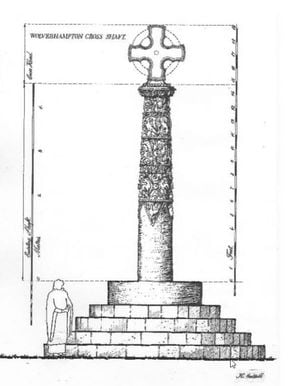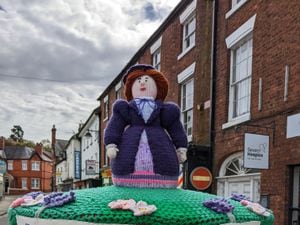Sculptor planted a mystery in city's Saxon cross
As the gifted Saxon sculptor carved his Wolverhampton masterpiece, he added a bit of Mediterranean mystery.

And it has had historians ever since scratching their heads.
In fact there's an awful lot that gets historians scratching their heads about the Saxon Cross shaft in St Peter's Gardens in the city centre.
How old is it? How did it get there? What happened to the cross on top? And so on.
Keith Cattell, an 87-year-old retired architect from Wolverhampton, has been pulling together what we know, and don't know, about the exquisitely carved column in the city centre.
"The current accepted view of its original appearance was from a drawing that I prepared almost 60 years ago, but I now believe that is incorrect, so I am anxious to put the record straight while I am still compos mentis," he says.
So what does he think was wrong with the drawing he prepared early in 1962?
That drawing showed the column – that's the bit that's still standing – with a long tapered shaft on top, and then a cross on top of that. The problem is that being at the highest point in what is now the town centre, such a tall, three-piece, structure would have probably blown over in a gale.
He now believes that the cross was placed directly on top of the existing column.
Keith says the cross shaft is the oldest relic of Wolverhampton's early history, and the most ancient edifice in the West Midlands conurbation.
"Yet many Wulfrunians do not seem to be aware of its existence."
There have been disputes about its age in the past, but he says: "The air has cleared over the last 80 years and it is now known to be Saxon in origin and created within an approximately 100-year time frame. It deserves a distinguished place in any catalogue of Anglo-Saxon art."
The timespan for its erection is from about 850AD to 950AD.
Sadly it has suffered badly from pollution and weathering, but happily a cast, now in storage, was made from it in 1877 which preserved the splendour of the decoration.
That takes us on to the Mediterranean mystery, because it includes two narrow bands of acanthus leaf decoration.
"The acanthus leaf was a popular decorative motif in classical Greece and Rome and would have been seen in this country during the Roman occupation, but being a Mediterranean plant, it normally played no part in Saxon work."
Nevertheless it did make a couple of brief British appearances, one of these being its arrival in the middle of the 10th century as part of the cultural ethos that accompanied the Benedictine reform period. One expert believes it was this school of design which inspired the Wolverhampton sculptor.
Well, we say Wolverhampton sculptor, but there was no Wolverhampton then. We've also made the not unreasonable assumption that in those unequal days the sculptor would have been male.
Keith says: "It is difficult for us today to appreciate the artistic dichotomy that the carving on the Wolverhampton column illustrates. It's not unlike inserting a strip of Art Deco decoration into a Robert Adam classical frieze.
"It is unlikely we will ever know what prompted our gifted Saxon sculptor to include bands of classical acanthus decoration within his brilliant traditional and lively Saxon carving."
Then there's the puzzle of where the column is from. It is of hard sandstone, quite unlike the sandstone in Wolverhampton area.
There is, says Keith, a tradition that it is a recycled column from the Roman city of Uriconium in Shropshire. And it seems that it is a tradition that has got legs, as there are various indications which would support the theory.
"The column weights approximately 3.6 metric tonnes, so dragging it to Heantun (the old name for Wolverhampton), probably initially along Watling Street, must have represented a considerable physical feat, as well as a strong act of faith. It is generally agreed that it would not have been recarved until it had been erected on its present site.
"The Wolverhampton column appears to be unique in that it is the only monolithic Roman column in Britain that has probably been standing since it was first erected nearly 1,900 years ago, apart of course from its brief journey to Wolverhampton."
Originally it may have been coloured – perhaps ochre, brick red, white and possibly black.
But what happened to the cross on top? Nobody knows, but the Puritans are the usual suspects, probably knocking, or taking, it off.
Keith says: "Not knowing the nature of the tragedy that befell our cross head, it is not beyond the realms of possibility that it could reappear at some time in the future during church building repair or excavation works."
Regarding the future, proposals had been put forward to move the column into St Peter's Church, but much importance was placed on the fact that it had stood in the same position for the last 1,100 years or so, a view backed by English Heritage which felt something would be lost if it was moved.
"A relatively simple improvement could be made to the column's appearance by removing the rubble stonework around its base, that was obviously placed there as a very crude method of preventing the column from falling.
"This was carried out at some unrecorded date, probably in the late 18th or early 19th century.
"We owe it to future Wulfrunians to do something to preserve this Saxon Christian work of art that is important not just for Wolverhampton, but as the West Midland conurbation's oldest Christian monument."





